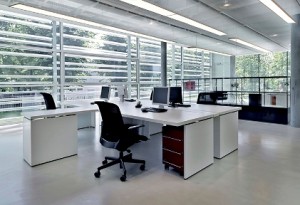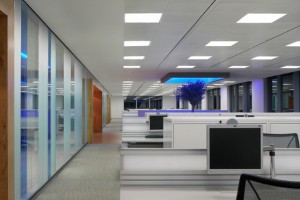LED lights are more energy efficient than fluorescents, but they're also more expensive. And for commercial buildings, a higher upfront cost — even if it makes a return on investment over time — can be hard to overcome. By partnering up, Lunera Lighting and Lutron Electronics hope they can help change that equation and tip the balance in favor of LEDs.
Lunera, a 5-year-old commercial-lighting-fixtures company, is integrating Lutron's wireless lighting controls into its LED fixtures so they won't need to be installed separately, vice president of sales Tom Quinn told me Tuesday. (Lutron, a large provider of dimmers, ballasts and other lighting-control devices and systems, has been working in lighting controls for 51 years.) The companies plan to ship the first two integrated products, a 2- by 2-foot recessed troffer and a suspended linear pendant, by early January. They're now working to get UL certification for the products.

These suspended linear LED fixtures from Lunera will soon come equipped with integrated controls.
The main advantage of combining the fixtures and controls is that it cuts manufacturing costs. Lunera expects to sell the integrated LED lights at prices competitive with that of equivalent fluorescent lights plus controls: The troffer will sell for less than $200 and the suspended linear fixture for $75-$80 per foot, Quinn said. "We're effectively bringing price parity to that discussion," said Andrew Lawler, manager for control technology at Lutron.
If the companies are indeed able to offer a comparable price to fluorescents, "it's definitely a big deal," said Eben Jose, a research analyst at IBISWorld. "Right now, what's holding LEDs back from taking over is the price aspect." As it is, LEDs "are blowing up," while fluorescents are declining, he said. Jose expects LED bulb manufacturing to grow at an annual average rate of 3.4 percent to reach nearly $1 billion in 2017.
Most LED companies today talk about payback, or how long it takes to make up the higher upfront costs in lower energy bills. If LEDs come to the same price as fluorescents – if you include both the light fixtures and the controls – customers will likely prefer LEDs because of their greater energy efficiency and longer life, Jose said.
LEDs use 50 percent less energy than fluorescents, according to Lunera, and last twice as long. Lunera estimates it can save commercial developers between 50 cents and $1 per foot per year in operating expenses, while helping them get higher lease rates, increasing their overall net operating income.
Integrated controls also make the fixtures easier and less expensive to install, and bring additional energy savings. LEDs use 50 percent of the energy of fluorescents, and control strategies – no matter what the light source – can cut the amount of electricity spent on lighting by 60-70 percent, Lawler claims.

These commercial LED lights, called troffers, will come with embedded controls and will sell for less than $200 each.
"Of course you save the most energy when the lights are off," Lawler says. "But you can't turn the lights off all the time, because of productivity. If you only have two choices – all on or all off – you're not reaping the benefits of energy savings in between. This allows you to save energy even when the lights are on."
By combining LEDs with wireless controls, the companies hope to take a big chunk out of commercial energy costs. Lighting is the largest consumer of electricity in buildings, accounting for approximately 40 percent of the average electricity usage.
A growing trend
If embedding controls offers so many benefits, why aren't fluorescent bulb manufacturers also doing it – and reaping the same savings? It's easier to integrate controls into LED lights, which are electronic, than into fluorescents. "It makes a whole lot more sense with LEDs," Lawler said. Or, as Quinn put it, "Anytime something's in a digital format, it wants to be controlled; it's easy to control."
Lunera isn't alone in its move to integrate controls. Philips has announced it is developing integrated LEDs – and last week began selling a residential LED lighting system at Apple stores – and CREE launched commercial LED lighting integrated with Lutron controls back in May. Both of those companies are much larger than Lunera, making up 43.1 percent and 52.2 percent of the LED manufacturing market, Jose said.
Integrated controls represent a natural progression for the industry, he added. "A lot of companies are starting to integrate with other technologies. … It's just more efficient to have them integrated."
Right now, integration is a way for companies to stand out amid growing industry competition, he said. But in the next five years, Jose expects control-integrated LEDs will become more commonplace. That will likely grow the overall market for LEDs, but is less likely to give any one company a significant advance in the long-term.
Jose expects this trend will result in mergers, with bulb manufacturers buying up the fixtures and the controls, but not necessarily an industry contraction because new companies will enter the market.
Lawler emphasized that the Lunera-Lutron partnership is not "a legal partnership" on the way to a merger. The deal is nonexclusive.
Taking control
Compared to fluorescents without controls, of course, LEDs are still more expensive. But energy efficiency has been a growing priority for commercial builders, according to Jose, who expects lighting controls to become more commonplace in commercial properties over the next five years. "It's definitely a trend in the industry and something on the minds of commercial builders," he said.
Separately, Lunera and Lutron have seen a growing number of property managers invest in LEDs and in digital controls, respectively. New building codes are driving some of this investment, as well as the desire to attract more tenants. In California, for example, commercial buildings must meet a "daylight harvesting" requirement to make use of natural light. For buildings without lighting controls, that might involve turning whole lamps on or off, which doesn't make for a good user experience, Quinn claims, calling continuous dimming a more "elegant" solution.
With the new integrated products, buyers would still have to install any sensors or manual controls – like dimmer switches – that they want. But they wouldn't have to install dimming ballasts or other equipment to the fixtures to make the lights dimmable and controllable. "There's an extra box that you typically have to get installed in the fixture, but now you don't because that component has been integrated into the fixture itself," Lawler explained.
Users would be able to program lights to automatically turn on and off when people are in the room, to adjust light levels to the amount of daylight coming into a room and to turn on and off or dim at different times via the Internet. With the linear suspended light, users will be able to control the uplight – or the light directed upward toward the ceiling – separately from the downlight – the light directed downward toward cubicles or work stations – so that, if an employee leaves, that light can be turned off without affecting the entire room, Quinn said.
Because the integrated lights will also be able to send digital information back and forth, building owners and managers will be able to get more information about energy consumption than they could with separate controls today, Lawler said. All that information would also make it easier for companies to participate in utility demand-response programs, in which they agree to use less electricity when needed to avoid a power outage in exchange for lower electricity rates, he added.





